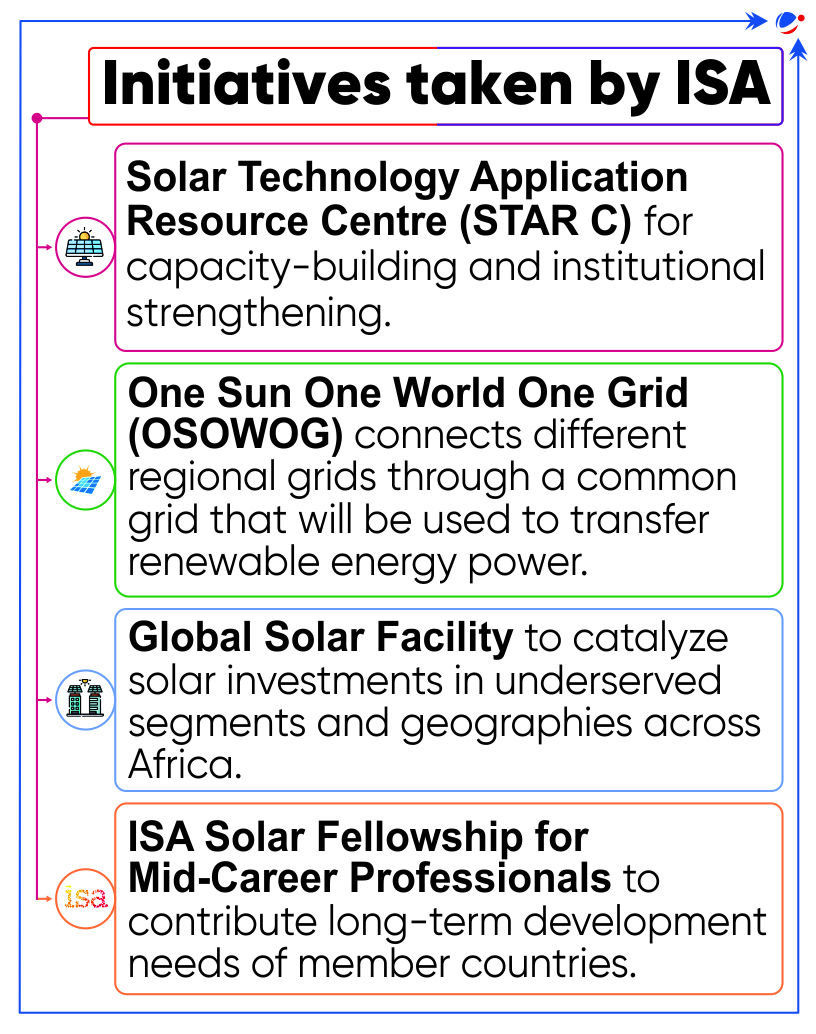Why in the News?
Recently, Paraguay became the 100th country to join the International Solar Alliance (ISA).
Global Energy Transition Landscape
- The current trajectory towards Sustainable development is misaligned with the Paris Agreement's goal of limiting global warming to 1.5℃.
- Current projections suggest that by 2050 there will be only a moderate 4% reduction in global emissions, pushing the rise in global warming to an alarming 2.4℃. (ISA)
- Global emissions must be cut by 43% in this decade for the world to reach the 1.5°C limit agreed in Paris. (UNFCCC)
- The world requires $1.6 - $2 trillion in solar investment by 2030 (IEA).
Solar energy: A medium to fuel both growth and transition
- It is the most accessible and versatile renewable energy source.
- Exhibits highest potential at lowest costs: Low Levelized Cost of Electricity (LCOE) of $0.049/kWh while capable of producing 1600-49800EJ per year.
- Lower Carbon footprint compared to other renewable sources like hydropower and bioenergy.
- High Decentralization potential E.g. off-grid systems
- Advanced technological developments compared to other renewable sources.
- Remarkable growth rate with a 21% CAGR (2015-2022), surpassing wind, bioenergy and hydro energy.
- Projected contribution to the total energy mix is 27% by 2030, necessitating 3500 GW of capacity building.
- Penetration of solar energy in global RE capacity projected to increase from 28% in 2021 to 45% in 2030

Significance of ISA
- Energy equity and justice: Nuanced approach beyond one-size-fits-all.
- Differentiated approach for High-income countries, Emerging economies, Low-income countries and SIDS.
- Taking solar energy from lab to streets: Democratic access to technology and resources especially for developing and low-income countries.
- Creation of a global solar energy market: by encouraging large scale deployment with reduced cost and collaborative development. E.g. PM KUSUM scales solar application in agriculture.
- Facilitate standardised policies and procedures: To instil confidence in investors by offsetting risks. E.g. Standardised auction and Power Purchase Agreements (PPA) framework.
- Platform for collaborative Research and Development: Pool resources to improve R&D in developing countries which lack the financial capability.
- Significant shift in India's Foreign Policy: India's global leadership in sustainability to further strategic interests. E.g. Mission LiFE
- India is playing the role of a "bridge" between the Global North and the Global South in harnessing solar energy through ISA.
- India is also providing new normative norms in the domain of global energy governance, which will address the concerns of Global South countries. E.g. highlighting issues like greater technological diffusion, financial assistance etc.
Challenges for ISA
- Coordination issues among member states hindering effective implementation of initiatives. E.g. Issues like membership rights, importance to procedure over pragmatism are potential roadblocks.
- Geopolitical challenges: China dominates the global solar supply chain, which is a hindrance to the achievement of energy equity.
- Private sector participation: In most developing countries, power falls under the public sector domain and involvement of private sector, although important for scaling, may make renewable energy inaccessible, hindering energy equity and justice.
- Implementation issues: Issues of land acquisition and potential ecological harm caused by the land-intensive solar deployment. E.g. Of the 50 Solar Parks sanctioned, only 11 are completed till 2023.
- Technical challenges E.g. Grid integration.
Way Forward
- Address challenges related to solar energy: Unequal global solar energy access due to regional disparities in adoption costs etc.
- Ensure equity in ensuring energy security: Decoupling of per capita energy consumption with energy intensity with focus on people-centric growth.
- Focus on Energy Equality: Along with scaling renewable energy production, focus must be on inclusion of all stakeholders with a bottom-up approach to solar proliferation.
Conclusion
India's initiatives like ISA, the Green Hydrogen Innovation Centre and the Global Bio-Fuel Alliance demonstrates India's capability in shaping new discourses on global renewable energy rooted in the age-old Indian traditional ethos of "Vasudhaiva Kutumbakam."
 Case Studies
|



